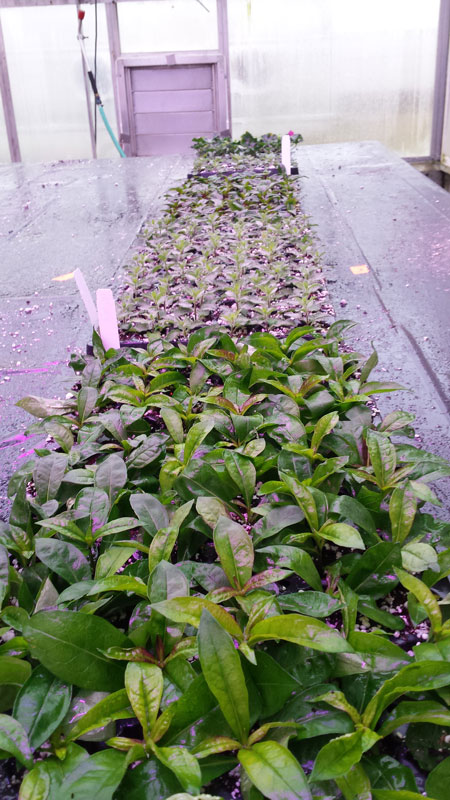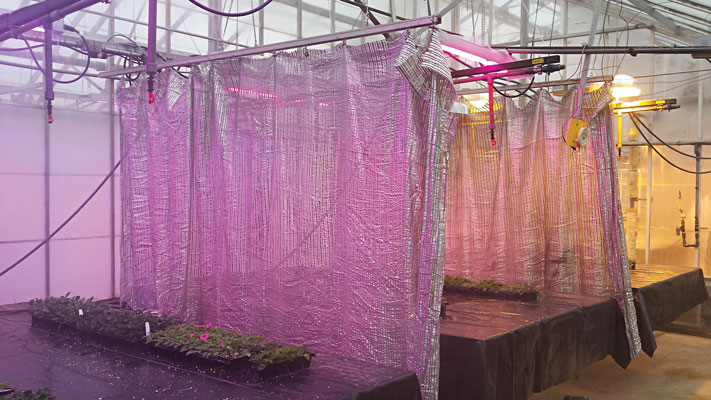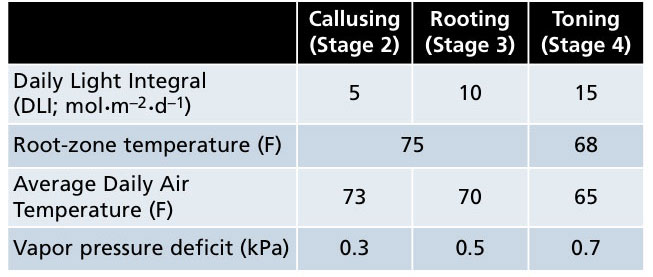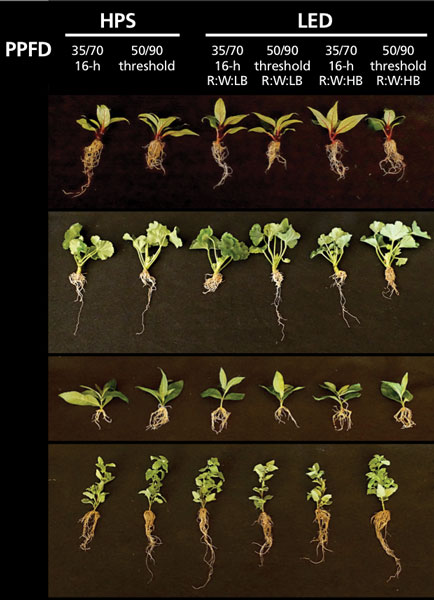11/1/2017
Producing High-Quality Rooted Cuttings
Allison Hurt & Roberto Lopez

Part 3 of a four-part series on manipulating light quality and quantity during liner production.
In this third article of a four-part series, we’ll be looking at how light quality (wavelength or color) and quantity (intensity) effect callusing and rooting of vegetatively propagated annual and perennial cuttings.
In parts 1 and 2, we shared the set-up and results, respectively, of an experiment that compared several constant and threshold supplemental and photoperiodic lighting treatments and their effect on bedding plant plug production and quality. In part 3, we’ll be looking at rooting of annual and perennial cuttings under constant and threshold supplemental lighting using high-pressure sodium (HPS) lamps and light-emitting diode (LEDs) arrays containing a low and high percentage of blue light.
Over the last decade, our research has quantified how daily light integral (DLIs; ≈1 to 15 mol•m−2•d−1), light quality from LEDs (red and blue radiation) and/or root-zone temperature (RZT; 68, 75 and 82F) influence rooting, growth, quality and subsequent flowering of the following annual and perennial genera: achillea; agastache; angelonia; argyranthemum; coreopsis; diascia; gaillardia; gaura; heuchera (coral bells; two cultivars); Impatiens hawkeri (New Guinea impatiens; four cultivars); lamium; lantana; leucanthemum; nemesia; osteospermum; perovskia; pelargonium (geranium; two cultivars); Pennisetum x advena (purple fountain grass); petunia (four cultivars); phlox (garden phlox); salvia; scaevola; sutera (bacopa); and verbena.
For nearly all of the 33 genera and cultivars we’ve investigated, as DLI increased from ≈1 to 12 mol•m−2•d−1, overall rooted cutting quality increased and time to produce a marketable liner decreased by one to three weeks. For petunia, geranium and New Guinea impatiens cuttings, we didn’t find any positive or negative effects of utilizing LEDs providing a light ratio (%) of 0:100, 15:85 or 30:70 red:blue radiation as rooting, quality, photosynthetic rates and subsequent flowering were similar to cuttings rooted under HPS lamps. Therefore, for most genera, we recommend following the DLI, RZT, air temperature and vapor pressure deficit guidelines in Table 1 for Stages 2 to 4 with the exception of coral bells.
 Since most LED fixtures can be more energy-efficient to operate than traditional HPS lamps, our next step was to determine if there was any benefit from running them continuously at a lower intensity even if the sun was out. Alternatively, we wanted to determine if it was more beneficial to run LEDs providing a low or high amount of blue radiation at a higher intensity in the morning, when it was cloudy and in the evening. Therefore, our objectives were to quantify how the spectral quality and intensity of LED supplemental lighting will influence callus development and rooting of annual and perennial unrooted cuttings compared to those under HPS lamps.
Since most LED fixtures can be more energy-efficient to operate than traditional HPS lamps, our next step was to determine if there was any benefit from running them continuously at a lower intensity even if the sun was out. Alternatively, we wanted to determine if it was more beneficial to run LEDs providing a low or high amount of blue radiation at a higher intensity in the morning, when it was cloudy and in the evening. Therefore, our objectives were to quantify how the spectral quality and intensity of LED supplemental lighting will influence callus development and rooting of annual and perennial unrooted cuttings compared to those under HPS lamps.
The study
Cuttings of Pelargonium x hortorum Fantasia Cardinal Red (geranium), Impatiens hawkeri Clockwork Orange (New Guinea impatiens), Phlox paniculata Laura, Nepeta x faassenii Junior Walker (catmint) were received at Michigan State University, East Lansing, Michigan (lat. 42°N), during Weeks 2 and 7.
Upon arrival, annuals and perennials were stuck in square 72-cell trays and hexagonal 72-cell trays, respectively. Trays were filled with a 50/50 peat and perlite substrate that was thoroughly moistened. Trays were subsequently placed in a glass-glazed greenhouse with an air temperature set point of 73F (23C) and a root-zone temperature set point of 75F (25C) that was maintained by bench top root-zone heating (Figure 1).
A vapor pressure deficit of 0.3 kPA was maintained by injected steam. Mist containing reverse osmosis water supplemented with water-soluble fertilizer that provided 60 ppm nitrogen (N) was provided as needed during the first two weeks of propagation and hand irrigated during Week 3 with 200 ppm N.

Lighting treatments
Liner trays were placed on individual benches, which were under one of six sun light + supplemental lighting treatments, all providing a 16-hour photoperiod. The supplemental lighting treatments were created by utilizing one of the following three fixtures: 200-watt LED fixtures (Philips GP-TOPlight DRW-LB) providing a light ratio (%) of 6:0:94 blue:green:red (B:G:R); 200-watt LED fixtures (Philips GP-TOPlight DRW-HB) providing a light ratio (%) of 21:0:79 B:G:R; or 400-watt HPS lamps (P.L. Light Systems) (Figure 2).
Each of the three fixtures were either on continuously for 16-h•d–1 or on an instantaneous threshold lighting program. The continuous lighting treatments provided a PPFD of 35 µmol•m–2•s–1 during Stage 2 (callusing) and
70 µmol•m–2•s–1 during Stages 3 and 4 (rooting and toning).
The instantaneous threshold supplemental lighting treatments provided a PPFD of 50 µmol•m–2•s–1 during Stage 2 and 90 µmol•m–2•s–1 during Stages 3 and 4. Fixtures were on from 6:00 to 8:00 a.m. and 5:00 to 10:00 p.m. and only on between 8:00 a.m. to 5:00 p.m. when outside PPFD was <185 µmol•m–2•s–1 and switched off when >370 µmol•m–2•s–1.

Overview of what we found
Although there was a difference in the hours of operation and DLI (Table 2) between the threshold and continuous supplemental lighting treatments, we found no significant effect on callusing or rooted cutting quality or liner production time. For example, callus diameter, stem length and diameter, shoot and root dry mass of geranium, phlox and New Guinea impatiens were not influenced by any of the supplemental lighting treatments (Figure 3). With the exception of catmint, we found that height, root dry mass and overall quality varied slightly between treatments. However, there were no trends that were of commercial significance.
 While we didn’t see any positive benefits of utilizing LEDs during cutting propagation as we did with plugs, we also didn’t see any negative effects. Therefore, we can conclude that high-intensity LED fixtures are equally as effective as HPS lamps for supplemental lighting of both annual and perennial cuttings. Similar to plug production, our recommendations are to utilize threshold supplemental lighting with either HPS or LED providing 70 to 90 µmol•m–2•s–1 to save on energy costs and produce high-quality rooted cuttings. GT
While we didn’t see any positive benefits of utilizing LEDs during cutting propagation as we did with plugs, we also didn’t see any negative effects. Therefore, we can conclude that high-intensity LED fixtures are equally as effective as HPS lamps for supplemental lighting of both annual and perennial cuttings. Similar to plug production, our recommendations are to utilize threshold supplemental lighting with either HPS or LED providing 70 to 90 µmol•m–2•s–1 to save on energy costs and produce high-quality rooted cuttings. GT
Allison Hurt is an M.S. student and Roberto G. Lopez is Assistant Professor and Controlled Environment/Floriculture Extension Specialist in the Department of Horticulture at Michigan State University. The authors gratefully acknowledge Ball Horticultural Company and Syngenta Flowers for providing seed, Philips Lighting, and The Fred C. Gloeckner Foundation for funding and Nathan DuRussel for greenhouse assistance.